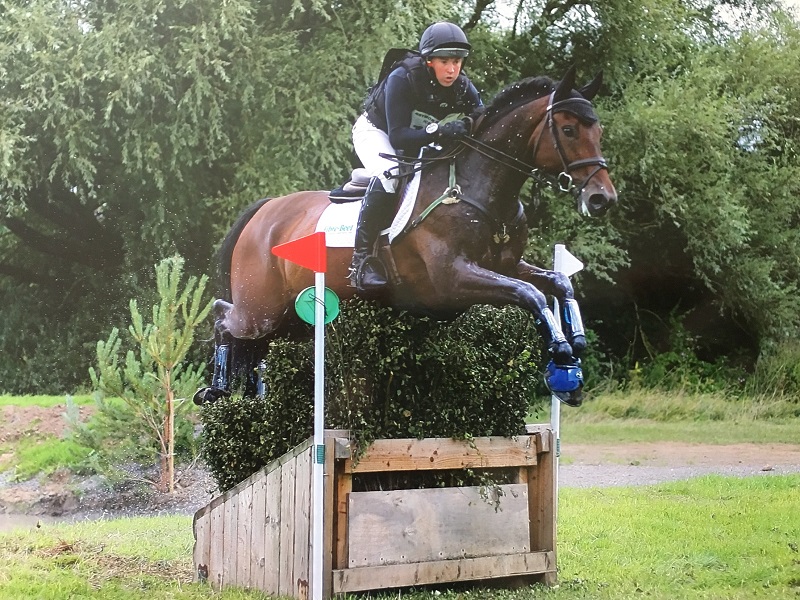Posted: 21st March 2018 | Back to news feed

Grub’s Boots sponsored rider James Sommerville, is based in Yorkshire and first started eventing in 2002. He has been competing against some of the biggest names in the sport and has a wealth of experience when it comes to the cross country phase. Here he provides some useful tips for cross-country success.

1 - How do you prepare for an event?
At home we do a lot of schooling incorporating a variety of exercises to get the horses listening and responsive to my aids. We combine this with one jumping session a week. We also include a lot of hacking to get the horses out and about while including canter work to build their stamina.
When the season approaches at the start of the year, the work load increases and we include lot more cross country schooling and showjumping. We prepare my main horse Talent for the major events by doing plenty of canter work and schooling to keep him focussed and relaxed.
2 - Walking the cross-country course is crucial to planning your round and to get a really good look at the jumps, is there anything else you look out for whilst walking the course?
We also look at what lines we would take approaching a fence and then on to the next as you can always shave a few seconds off your time by planning clever routes.
The undulation of the ground is also very important to take note of around the course so you can best prepare your horse and keep them in a good free-flowing rhythm.
I love to walk the cross-country course in my Grub’s Discover Shoes because of their snag resistant Diamond Rip-Stop™ nylon outer, making them a strong, versatile piece of footwear perfect for the outdoor terrain and unpredictable weather.
The waterproof, breathable Hydri-Fuse™ moisture wicking bootie lining, wicks away moisture and helps to provide a comfortable feel, keeping feet warm and dry whilst out walking the course.
3 - For some riders the cross-country can be a bit daunting, how do you tackle the nerves before you start?
I always think about my horse’s strengths, have a clear plan in my mind on how I want ride each fence and take deep breaths. The cross country phase can be daunting but it is also an exhilarating and exciting phase where you and your horse can really show what you can do.
4 - In the warm-up what exercises would you recommend to get your horse ready and listening?
There are a number of different exercises you can go through in the warm-up to get prepared. Going through the different gears in the canter and shortening and lengthening the stride to really engage the horse’s brain and focus is important.
Most riders would jump the practice fences head on but creating different angles and approaches will make sure your horse is listening to you and the question being asked which is essential when out on the course.
5 - Any tips for the start box?
Making sure you leave it on time is key! But for the horse it is crucial that the rider stays calm which in turn helps your horse to stay relaxed. If your horse isn’t good in the start box, having someone on the ground who can lead you in or walk around with you can help settle the horse.
6 – Achieving a rhythm is important because it takes less energy out of your horse. How do you accomplish this and get your horse settled in to a rhythm quickly?
Every horse has a different rhythm and your work and practice at home should ensure you know your horse well enough for when you are out competing. It is easy for you and the horse to get carried away with the atmosphere or adrenaline, so be conscious to let the horse travel at its’ own pace and not let them go too fast as you need steam in the tank to get across the final fence safely.
7 – Tackling the “tricky” fences, what’s the best approach?
It is so easy to over think these fences especially when they are so intimidating to the horse and rider, but the best and safest approach is coming in at the right pace and ride a good positive line encouraging the horse to be confident and brave.
8 – To get a good round riders have to be conscious about their time. Apart from the alternative routes available on the course, where else can you shave off a few seconds?
Taking tighter lines, be it between fences, on the approach or even leaving a fence quickly can save a few precious seconds. You will have a better idea after doing your course walk on where to save time.
9 – What do you do if your horse has a little wobble or is worried at a fence?
If they do get a little worried it is important that the rider gives the horse confidence with positive riding and sits back a little to put themselves in the safest position possible. Encourage the horse to move forward without giving your reins away will help to eliminate the possibility of them thinking they can run out.
A pat or rub after your horse has been brave can also give them a little boost.
10 – After the cross country phase, what do you do to make sure your horses are ready for the show jumping phase?
The main objective is to prepare and make sure that the horses are ready for the next day, which is my partner Lucie’s main job. Cooling off the horse’s legs after the cross country phase by using cool boots and ice is also important and making sure the horses are happy and well with plenty of water.
We use Activo-Med rugs to help the tired muscles recover and provide electrolytes to replace the lost salts excreted from sweat because of intense exercise.
In the morning on the showjumping day the horses go out for a little hack to make sure they are content and fit for the day ahead.
For further information please contact Grubs on 01204 567700 or visit www.grubsboot.com
The Equestrian Index newsfeed is compiled from articles submitted by advertising members and expresses the opinions of those members. Watsons Directories Ltd shall not be held liable for any inaccuracies or mis-statements therein.